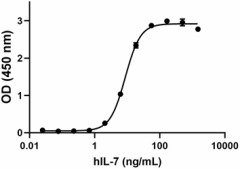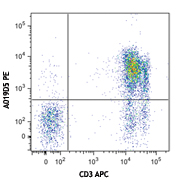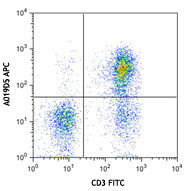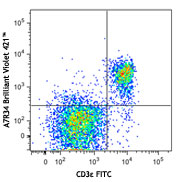- Regulatory Status
- RUO
- Other Names
- IL-7RA, IL-7 Receptor Subunit Alpha, Interleukin 7 Receptor, IL-7R-Alpha, CD127 Antigen, CDW127, Interleukin 7 Receptor Alpha Chain
- Ave. Rating
- Submit a Review
- Product Citations
- publications

-

Immobilized recombinant human IL-7Rα, at 2 µg/mL, binds recombinant human IL-7 (Cat. No. 581902) in a dose dependent manner. The ED50 for this effect is 4 - 20 ng/mL.
IL-7 was initially described as a stromal derived factor which is capable of inducing the growth of pre-B cells in vitro. IL-7 acts on a variety of cells through its receptor (IL-7R), a heterodimer consisting of IL-7Rα (CD127) and a common γc chain (CD132) shared by other cytokine (IL-2, IL-4, IL-9, IL-15, and IL-21) receptors. In addition, IL-7Rα is shared with TSLP. The generation of IL-7-deficient and IL-7Rα-deficient mice and monoclonal antibody blocking experiments confirmed the requirement of IL-7 for B-cell development in mice. Nevertheless, mutations in the α chain of the IL-7 receptor in patients with severe combined immunodeficiency (SCID) confirmed that IL-7 is indispensable for T-cell development in humans. However, the presence of B cells in these individuals suggests important differences between the role of IL-7 in murine and human lymphocyte development. Thus, although human B-cell development does not appear to require IL-7, immature human B cells do proliferate in response to IL-7. Nevertheless, most recent information suggests that IL-7 dependence in human lymphopoiesis increases during the progression of ontogeny in cord blood and bone marrow. IL-7 can be associated to hepatocyte grow factor (HGFβ) to form a hybrid cytokine (IL-7/HGFβ), which induces greater proliferation of CFU-S, SLPs, and pre–pro-B cells than does native IL-7. The hybrid cytokine signals through both IL-7R (IL-7Rα plus γc) and c-Met. Soluble forms of the IL-7R α chain (sCD127) have been identified. They are derived from alternative splicing and by release of membrane-bound sCD127. sCD127 acts as an antagonist and is increased by immune activation. sCD127 concentration is increased in Type I diabetes patients, and it is glycated. The glycated form does not act as an antagonist of IL-7–mediated T-cell expansion. Alterations of the soluble form of IL-7Ra influences risk of multiple sclerosis.
Product DetailsProduct Details
- Molecular Mass
- The 463 amino acid recombinant protein has a predicted molecular mass of approximately 52.7 kD. The DTT-reduced and non-reduced protein migrate at approximately 70 kD and 140 kD respectively by SDS-PAGE. The predicted N-terminal amino acid is Glu.
- Purity
- > 95% by SDS-PAGE gel as determined by Coomassie stained SDS-PAGE.
- Formulation
- 0.22 µm filtered protein solution is in PBS pH 7.2.
- Endotoxin Level
- Less than 0.1 EU per µg (0.01 ng/µg) cytokine as determined by the LAL method.
- Concentration
- 10-25 µg sizes are bottled at 200 µg/mL. 100 µg and larger sizes and larger are bottled at the concentration indicated on the vial.
- Storage & Handling
- Unopened vial can be stored between 2°C and 8°C for up to 2 weeks, at -20°C for up to six months, or at -70°C or colder until the expiration date. For maximum results, quick spin vial prior to opening. The protein can be aliquoted and stored at -20°C or colder. Stock solutions can also be prepared at 50 - 100 µg/mL in appropriate sterile buffer, carrier protein such as 0.2 - 1% BSA or HSA can be added when preparing the stock solution. Aliquots can be stored between 2°C and 8°C for up to one week and stored at -20°C or colder for up to 3 months. Avoid repeated freeze/thaw cycles.
- Activity
- Immobilized recombinant human IL-7Rα, at 2 µg/mL, binds recombinant human IL-7 (Cat. No. 581902) in a dose dependent manner. The ED50 for this effect is 4 - 20 ng/mL.
- Application
-
Bioassay
- Application Notes
-
BioLegend carrier-free recombinant proteins provided in liquid format are shipped on blue-ice. Our comparison testing data indicates that when handled and stored as recommended, the liquid format has equal or better stability and shelf-life compared to commercially available lyophilized proteins after reconstitution. Our liquid proteins are verified in-house to maintain activity after shipping on blue ice and are backed by our 100% satisfaction guarantee. If you have any concerns, contact us at tech@biolegend.com.
Antigen Details
- Structure
- Homodimer
- Distribution
-
High levels of soluble IL-7Ra in plasma indicate pathologic T-cell immunity in autoimmune, inflammatory, and chronic viral diseases.
- Function
- Modulation of T-cell functions, development and homeostasis of T cells, promotes antigen-specific T-cell responses, generation of memory T cells.
- Ligand/Receptor
- IL-7, IL-7/HGFβ
- Bioactivity
- IL-7R inhibits the proliferation of TF-1 cells.
- Biology Area
- Stem Cells
- Molecular Family
- Soluble Receptors
- Antigen References
-
- Park LS, et al. 1990. J. Exp. Med. 171:1073.
- Goodwin RG, et al. 1990. Cell. 60:941.
- Fry TJ and Mackall CL. 2002. Blood. 99:3892.
- Lai L, et al. 2006. Blood. 107:1776.
- Link A, et al. 2007. Nat. Immunol. 8:1255.
- Lundmark F, et al. 2007. Nat. Genet. 39:1108.
- Wofford J, et al. 2008. Blood. 111:2101.
- Parrish YK, et al. 2009. J. Immunol. 182:4255.
- Saini M, et al. 2009. Blood. 113:5793.
- Guimond M, et al. 2009. Nat. Immunol. 10:149.
- Monti P, et al. 2013. Diabetes. 62:2500.
- Lundtoft C, et al. 2017. PLoS Pathog. 13(6):e1006425.
- Gene ID
- 3575 View all products for this Gene ID
- UniProt
- View information about CD127 on UniProt.org
Related Pages & Pathways
Pages
Related FAQs
- Why choose BioLegend recombinant proteins?
-
• Each lot of product is quality-tested for bioactivity as indicated on the data sheet.
• Greater than 95% Purity or higher, tested on every lot of product.
• 100% Satisfaction Guarantee for quality performance, stability, and consistency.
• Ready-to-use liquid format saves time and reduces challenges associated with reconstitution.
• Bulk and customization available. Contact us.
• Learn more about our Recombinant Proteins. - How does the activity of your recombinant proteins compare to competitors?
-
We quality control each and every lot of recombinant protein. Not only do we check its bioactivity, but we also compare it against other commercially available recombinant proteins. We make sure each recombinant protein’s activity is at least as good as or better than the competition’s. In order to provide you with the best possible product, we ensure that our testing process is rigorous and thorough. If you’re curious and eager to make the switch to BioLegend recombinants, contact your sales representative today!
- What is the specific activity or ED50 of my recombinant protein?
-
The specific activity range of the protein is indicated on the product datasheets. Because the exact activity values on a per unit basis can largely fluctuate depending on a number of factors, including the nature of the assay, cell density, age of cells/passage number, culture media used, and end user technique, the specific activity is best defined as a range and we guarantee the specific activity of all our lots will be within the range indicated on the datasheet. Please note this only applies to recombinants labeled for use in bioassays. ELISA standard recombinant proteins are not recommended for bioassay usage as they are not tested for these applications.
- Have your recombinants been tested for stability?
-
Our testing shows that the recombinant proteins are able to withstand room temperature for a week without losing activity. In addition the recombinant proteins were also found to withstand four cycles of freeze and thaw without losing activity.
- Does specific activity of a recombinant protein vary between lots?
-
Specific activity will vary for each lot and for the type of experiment that is done to validate it, but all passed lots will have activity within the established ED50 range for the product and we guarantee that our products will have lot-to-lot consistency. Please conduct an experiment-specific validation to find the optimal ED50 for your system.
- How do you convert activity as an ED50 in ng/ml to a specific activity in Units/mg?
-
Use formula Specific activity (Units/mg) = 10^6/ ED50 (ng/mL)

 Login / Register
Login / Register 












Follow Us